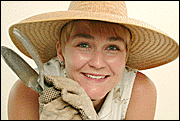Advertisement - Click to support our sponsors.


Dig This
![]()
Friday, May 12, 2000

By Kathryn Bender, Star-Bulletin
Hawaii home gardeners can grow perfectly beautiful
roses either in pots or the ground.
Preparing for
a rosy futureWhy is it no one ever sent me yetAMERICAN writer and cynic Dorothy Parker obviously was not an easy person to please.
One perfect limousine, do you suppose?
Ah no, it's always just my luck to get
One perfect rose.-- From One Perfect Rose, Dorothy Parker (1893-1967)
Fortunately for Tom Mui, his wife, Lois, could appreciate the beauty of a perfect rose. In the mid-'60s, Mui often stopped at Watanabe's on Monsarrat Avenue fairly regularly to buy his wife a gift of that most classic of all blooms.
Over time, he convinced himself it would be less expensive to grow them at home. He laughs about this now.
By the time Mui realized his logic was flaw-ed, however, he'd been hooked by the flowers' thorny charms.
Nearly four decades later, Mui, a partner in Chang, Mui and Chick Attorneys at Law, is a consultant rosarian and editor of Ka 'Uhane o Ka Loke, the Honolulu Rose Society's newsletter.
And he is happy to share what he knows about growing roses with anyone who cares to learn, though he insists there's really nothing to it.
"Most people think there is something mysterious about growing roses. There is not," he said. "Roses are tougher than they look.
"Dig a hole, put it in, water it. That's it. Everything else is refinement," said Mui.
Easy for him to say.
There are some basic rules for buying a healthy rose plant and keeping it healthy.
When buying bareroot roses, make sure the canes (stems) are green, not brown, said Mui. And that they have not begun to grow leaves.
When buying potted roses, look for healthy looking canes and dark green leaves, said Barbara Billand, member of the Honolulu Rose Society and chairwoman of tomorrow's Waianae Mall Rose Show. Avoid plants with black spots on leaves, a fungus, or powdery white mildew, she said.
Good plants available locally
If buying locally rather than through the mail, Mui recommends sticking to nurseries and garden shops as opposed to other retailers who may carry roses as a seasonal promotion. The nurseries are more likely to have kept the plants healthy, he said.Billand said an advantage of mail order is that most sellers guarantee their plants. But Mui said some local shops will take back a bad bush as well, if the customer saves the identifying medallion and if the plant is not completely dead.
Upon bringing home a bareroot rose, soak it for 24 hours or longer in plain water, or water mixed with a little B-1 vitamin, said Mui. Some say the nutrient promotes growth. "I don't know whether it does anything or not, but it does no harm," he said.
After the plant has been soaked, plant it in the ground or a pot.
Roses need well-drained soil and plenty of sun and water. Those criteria have bearing on the pot-vs.-soil decision.
Potting allows for greater control over soil and drainage, as well as sun exposure, as it allows plants to be moved easily. But potted plants need more frequent watering and have less room to stretch their roots.
Mui grows his roses in pots. "I'm too lazy to dig pukas. The bad thing about it is roses have to have room to expand," said Mui.
Therefore, 15-gallon pots would be ideal, but they are heavy. "I think for that kind of rose growing, you need a strong back and a weak mind," he said, allowing that a dolly might also work. But Mui uses mostly 10-gallon pots. The three perfectly round fist-sized blooms lying on the conference table in front of him suggest 10-gallon pots work just fine.
Once the well-chosen rose bush is planted, vigilance begins.
Growers must be on the lookout for beetles (pesky brown varmints that chew holes in leaves) and fungus, the black spots and white powder Billand mentioned.
"Typically, (rose plants) will have to be sprayed for insects as well as the fungus," said Elton Hara, manager of Star Garden Supply in Moiliili.
And while organic remedies, or the pick-and-squash method, work on beetles, effective rose fungicides tend to be chemical compositions, said Hara. "The fungus are diseases so if they are allowed to spread they will kill the plant," he said, adding there's usually plenty of time to get the problem under control before that happens.
Mui pooh-poohed the idea that the beetle and fungus problems mean roses are particularly hard to care for. "There are plant diseases that come with roses, there also are diseases that come with orchids or any other plant," he said.
Lots of help for growers
And there are enough rose afficionados out there that the novice rose grower should have no trouble getting help with any question.The expertise of the Honolulu Rose Society is available for a $6 annual membership fee. And that includes getting to tag along on the group's annual shopping spree to Kawahara Nursery in Waimanalo, where they get a once-a-year discount. (Sorry, the Year 2000 pilgrimage has already happened.) To join, call Gladys Watanabe at 488-4649.
There also is a wealth of information available online, starting with the American Rose Society Website, www.ars.org.
Or head to Waianae tomorrow for the society's annual pre-Mother's Day show. Flowers fresh from members' gardens will be on sale. Billand said she's not anticipating having plants for sale, but you never know what the members will bring.
Honolulu Rose Society
What/Where: Waianae Mall Rose Show
When: 10 a.m. to 2 p.m. tomorrow
Admission: Free
Call: 696-3058
Gardening Calendar in Do It Electric!
Stephanie Kendrick's gardening column runs Fridays in Today.
You can write her at the Star-Bulletin, P.O. Box 3080, Honolulu 96802
or email skendrick@starbulletin.com